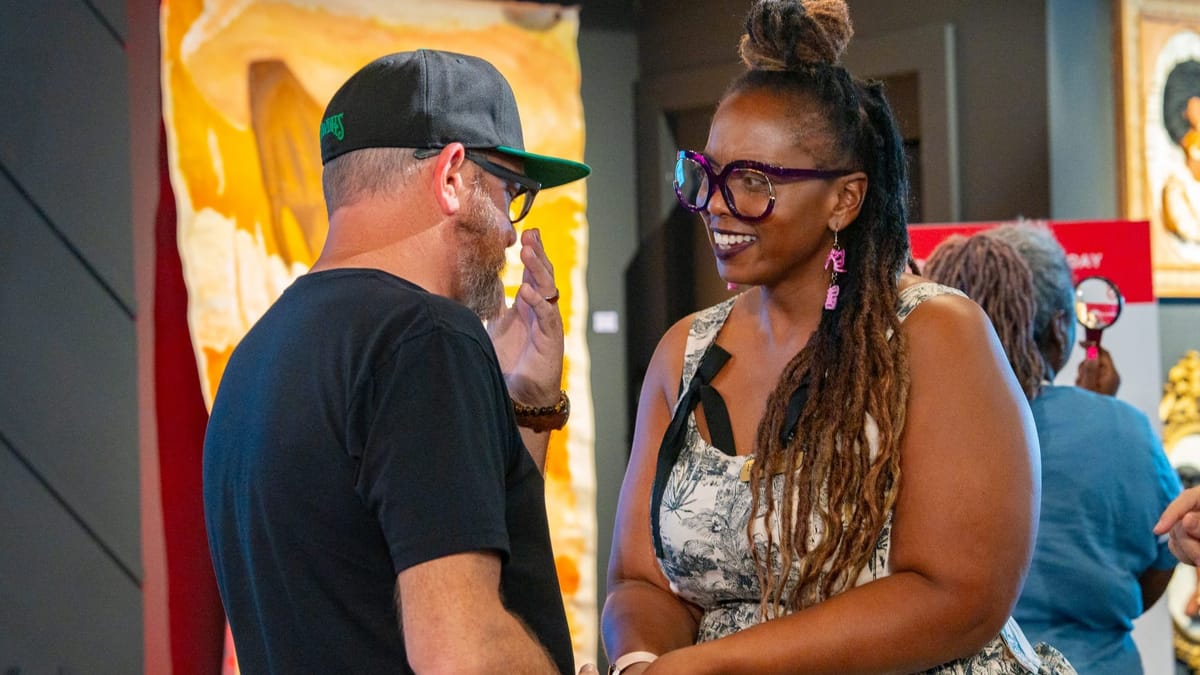A Year In: Erica Sutherlin’s First 12 Months at The Studio@620

By Avery Anderson
ST. PETERSBURG, Fla. — Erica Sutherlin didn’t mark her one-year anniversary at The Studio@620 with a celebration. “I literally came to work and worked,” she said. “I didn’t even celebrate it.”
In some ways, that quiet Tuesday was fitting. Her first year as Artistic Executive Director has been less about milestones and more about endurance—navigating financial strain, state funding cuts, a hurricane season, and the weight of inheriting a legacy. “Taking over from a founder is extremely difficult,” she said. “And I think taking over an organization that... is at a crucial stage of how and if, and can it move forward, makes the work hard.”
The load, she admits, is heavy. And it’s personal. “I’m trying not to drown,” she said. “I’m constantly and perpetually overwhelmed.”
Sutherlin’s voice tightened as she spoke about the toll the year has taken. “I don’t get to cry in front of my staff,” she said. “I don’t get to show them how much that loss of state funding hurt the organization—how much more stress that puts on me to find other revenue streams. Or how I might have to let you go… even when I need you.” Her hands stay steady at the helm, but the cost of that composure is high. “I don’t think I’m grounded,” she said. “Self-care? We’re working on it.”
In a particularly vivid metaphor, she described the feeling not as sinking, but as something more chaotic: “You know when there’s a mosh pit and the person on stage jumps into the crowd and just gets passed along with no control? That’s what I feel like. I don’t know who’s passing me, I don’t know where the end is, and it’s just uncomfortable.”
And yet, she shows up.
That persistence is visible in every corner of the organization—from programming to paint. One of the moments Sutherlin is most proud of isn’t a show, but the Studio’s spring open house. “They got to see the outcome,” she said, “but they have no idea the journey.” With little budget, she and her team transformed the space into a vibrant, welcoming venue. “I always say Black women can take something and just make it work and stretch it. That’s what we did.”
That same spirit fueled the Studio’s production of The Light, the first show under her leadership. The set was cobbled together with pieces from staff members’ homes—her own, Patrick’s, Charlotte’s. They used a broom handle as a curtain rod and forgot to replace it. “But nobody noticed,” she laughed. “It was just a good time.”
What she values most, though, are the sparks—watching students find their voice through storytelling workshops, or seeing artists light up when given the space to share themselves without performance pressure. “That’s why I get up every day,” she said. “Somebody has to create a space for artists to grow and evolve and share and collaborate. Because somebody created that space for me.”
But the job has changed her. “This role changed me as a human and as a leader,” she said. “I grew up in this role... I was grown coming into it, but I’m grown-grown now.”
Sutherlin is candid about what’s at stake. She’s had the hard conversations with herself: What if this doesn’t work? What if I have to be the one to say this isn’t sustainable? “But I’ve also told myself, if this place doesn’t exist, I didn’t fail. I did all the things I could possibly do to keep it afloat.”
She’s working to build something that lasts—not something built around her, but something rooted in the community. “The Studio can’t be about Erica. It can’t even be about Bob,” she said, referencing founding artistic director Bob Devin Jones. “It has to thrive on its own—fed by the community and giving back to it. I’m just here to steer for now.”
As she looks ahead to her second year, Sutherlin is focused on collaboration, new partnerships, and expanding the Studio’s programming. She speaks with clear-eyed optimism—measured, but hopeful. “I’ve got faith and hope,” she said. “Not in some mystical way, but real belief in humanity. That we all do have a common ground about survival.”
That’s what she wants the community to understand.
“I want you to go, ‘I love coming to The Studio. I didn’t think I was going to like that show, but it surprised me, it moved me, it made me think.’ I want you to leave having grown in some way,” she said. “This place isn’t mine. It’s yours.”
In speaking so candidly about overwhelm, uncertainty, and the deep responsibility of leadership, Sutherlin offered something rare in arts administration: transparency not just about vision, but about vulnerability.
